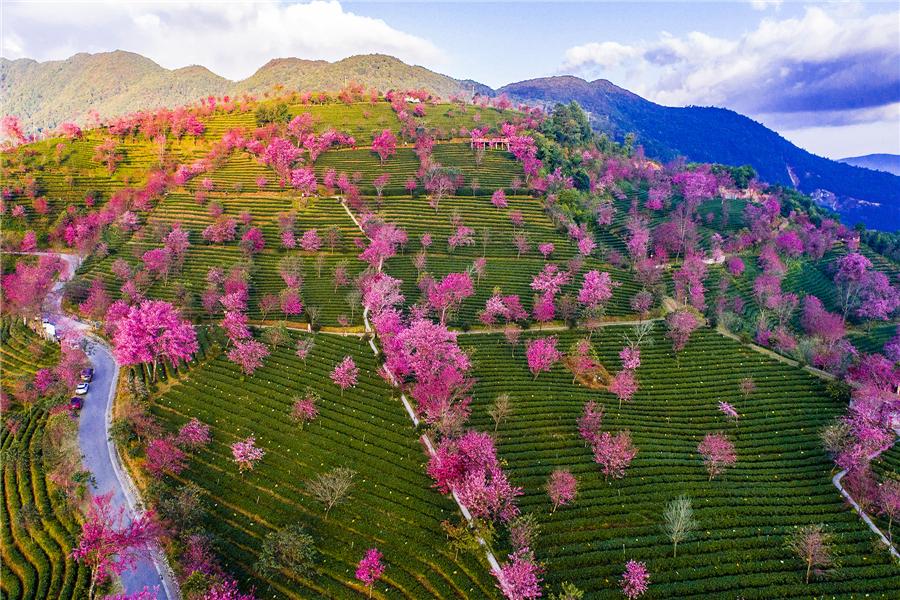
Tea Garden of Wuliangshan Cherry Blossoms Valley in Nanjian County, Dali
Chinese Name: 南涧县无量山樱花谷茶园
English Name:Tea Garden of Wuliangshan Cherry Blossoms Valley in Nanjian County, Dali
Location:大理州南涧县无量镇德安村委会
Dali Wuliangshan Cherry Blossom Valley Tea Park
Location and Overview: Dali Wuliangshan Cherry Blossom Valley Tea Park is situated in De’an Village, Wuliangshan Town, Nanjiang County, Dali Prefecture, Yunnan Province, at an elevation of 1,800 to 2,500 meters. It is adjacent to the Lingbao Mountain Forest Park, a national nature reserve. The park offers a chance to experience the unique natural beauty and historical culture of Dali, while also providing a relaxing retreat into nature. Visitors can enjoy the romantic sight of blooming flowers in winter and participate in tea-making techniques that are part of Dali Prefecture’s intangible cultural heritage, including sun-dried green tea and Phoenix tuo tea.
Historical and Cultural Background:
- Tea Origin: Wuliangshan Cherry Blossom Valley is a AAA-rated scenic area centered around tea. In 2000, Nanjiang County introduced a Taiwanese investment enterprise to establish the Yunnan Dali Huaqing Tea Co., Ltd. in De’an Village, located in the Wuliangshan National Nature Reserve. The company planted over 1,000 acres of tea varieties, including Tieguanyin, Qingxin Oolong, and Jin Xuan. Cherry trees were planted among the tea fields both for shade and as ornamental trees. From late November to December, the cherry blossoms create a stunning visual contrast against the green tea hills, attracting many visitors who enjoy the picturesque scenery and cultural atmosphere.
- Development and Recognition: In 2015, Wuliangshan Cherry Blossom Valley was developed into a national AAA scenic area. The park was recognized in 2023 as the “Dali Wuliangshan Cherry Blossom Valley Tea Park” by the China Agricultural International Cooperation Promotion Association.

Impact on Local Tea Industry:
- Tea Industry Development: The tea industry is a traditional strength of Nanjiang County, which has a long history of tea production. The county is a major tea-producing area in Dali Prefecture and Yunnan Province, known for its ecological tea production and integration of agriculture and tourism. Yunnan Dali Huaqing Tea Co., Ltd. has been recognized as a provincial tea garden and Wuliangshan Cherry Blossom Valley is the county’s first and currently only national AAA scenic area. The valley has been highlighted for its tea tourism routes and has received numerous accolades, including recognition as one of China’s top ten tea tourism destinations.
Access and Transportation:
- Travel Routes: Nanjiang County is a key node in the China-ASEAN International Grand Corridor. After the completion of major transportation projects like the Dali-Lincang Railway, Nanjing Expressway, Dali-South Expressway, and Binan Expressway, Nanjiang will be an important gateway to South Asia and Southeast Asia. Visitors can reach Dali by plane or high-speed train and then drive through the Dali-Nanjiang section of the Nanjing Expressway or the Binan Expressway to reach Wuliangshan Cherry Blossom Valley. The drive from Dali takes about two hours, or visitors can travel via the Xiaowan East Station and continue on the Nanjing Expressway to the park.

Tourist Attractions and Experiences:
- Tourist Route: The park is part of a broader tourist route that includes Nanjiang County Town, Nanjiang Earth Forest, Tea Horse Road Station (Tiger Street), and Wuliangshan National Forest Park. The county town features various parks and cultural sites, while the Earth Forest offers dramatic natural sculptures. Tiger Street, located in the middle of the route to the tea park, features well-preserved historical architecture and a museum built from old inns along the Tea Horse Road.
- Seasonal Highlights: Wuliangshan Cherry Blossom Valley presents different scenic views throughout the year. In addition to cherry blossoms in winter, visitors can see camellias in spring and explore misty tea mountains in summer and autumn. The peak flower viewing season is from late November to early December and from February to March for spring blooms.

Cultural Heritage Experiences:
- Cultural Activities: The park offers opportunities to engage with local cultural heritage, including the “Yi Ethnic Dance” listed as a national intangible cultural heritage. The techniques of making sun-dried green tea and Phoenix tuo tea, both included in Dali Prefecture’s intangible cultural heritage list, can also be experienced. Phoenix tuo tea is renowned in the industry and known as the “Second Best Tuo in the World.” Visitors can enjoy Yi ethnic dance performances, taste local delicacies, and participate in tea-making activities.

 7 Days GolfingTour
7 Days GolfingTour
 8 Days Group Tour
8 Days Group Tour
 8 Days Yunnan Tour
8 Days Yunnan Tour
 7 Days Shangri La Hiking
7 Days Shangri La Hiking
 11 Days Yunnan Tour
11 Days Yunnan Tour
 6 Days Yuanyang Terraces
6 Days Yuanyang Terraces
 11 Days Yunnan Tour
11 Days Yunnan Tour
 8 Days South Yunnan
8 Days South Yunnan
 7 Days Tea Tour
7 Days Tea Tour
 8 Days Muslim Tour
8 Days Muslim Tour
 12 Days Self-Driving
12 Days Self-Driving
 4 Days Haba Climbing
4 Days Haba Climbing
 Tiger Leaping Gorge
Tiger Leaping Gorge
 Stone Forest
Stone Forest
 Yunnan-Tibet
Yunnan-Tibet
 Hani Rice Terraces
Hani Rice Terraces
 Kunming
Kunming
 Lijiang
Lijiang
 Shangri-la
Shangri-la
 Dali
Dali
 XishuangBanna
XishuangBanna
 Honghe
Honghe
 Kunming
Kunming
 Lijiang
Lijiang
 Shangri-la
Shangri-la
 Yuanyang Rice Terraces
Yuanyang Rice Terraces
 Nujiang
Nujiang
 XishuangBanna
XishuangBanna
 Spring City Golf
Spring City Golf
 Snow Mountain Golf
Snow Mountain Golf
 Stone Mountain Golf
Stone Mountain Golf


















